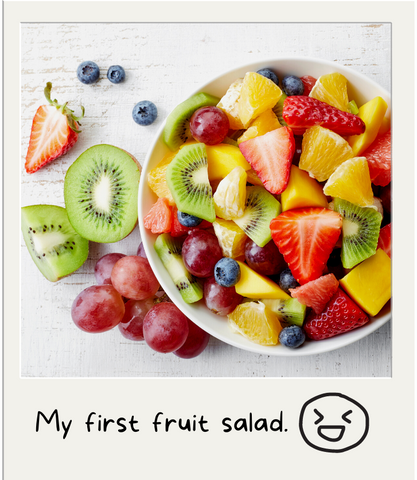Deciding what to put on your child's plate can be time-consuming and stressful. But we know how important it is to help your child eat well, be more active, and grow up healthy. Children require help in developing lifelong healthy eating habits. We prepared a plant-based vegan Chef Kids Plate guide at the end of this blog to encourage healthy eating and a balanced diet.
When creating a plant-based plate for your Chef Kid, choose variety — the best meals include items from for major food groups. These groups consist of fruits, vegetables, legumes, and grains.
Fruits
Fruits contain a lot of fiber, potassium, vitamin C, and folate. Include at least one serving of vitamin C-rich fruits a day. For example, citrus fruits, melons, and strawberries are great options. Fruit servings should primarily consist of whole fruits that are fresh, canned in 100% fruit juice, frozen, or dried. 1 small apple; 1 plum; 1/2 cup sliced or chopped banana, mango, or melon; 1/2 cup 100% juice; 1/4 cup dried fruit; or one 4-ounce snack container of unsweetened applesauce or fruit cocktail canned in juice equals one serving.
Vegetables

Vegetables are high in nutrients, such as beta-carotene, folate, potassium, vitamin C, fiber, and many others. Calcium* and vitamin K are in dark green vegetables such as kale and broccoli. For most vegetables, one serving is equal to 1/2 cup cooked or raw. 1 cup of raw leafy greens, such as spinach, romaine lettuce, and bok choy is a serving.
Whole Grains

Grains are high in fiber, complex carbohydrates, protein, B vitamins, and magnesium. Limit your intake of refined grains and sweets like cookies and cakes. 1 slice bread; 1/2 cup cooked rice, pasta, or cereal; one 6-inch tortilla; 1 cup cold cereal; or 1/2 bun or bagel is one serving.
Legumes

Protein, iron, zinc, and B vitamins are in beans, lentils, soy, nuts, and seeds. Black beans, pinto beans, garbanzo beans or chickpeas, lentils, split peas, and black-eyed peas are examples of legumes and lentils. 1/2 cup cooked beans and lentils equals one serving. 1/4 cup of hummus equals one serving. Almonds, walnuts, peanut butter, pumpkin seeds, and sesame seeds are examples of nuts, seeds, and soy. 1-ounce mixed nuts, 2 tablespoons peanut or almond butter, 1/2 cup tofu, 2 ounces tempeh, 1 soy veggie burger patty, or an 8-ounce glass of unsweetened soy milk equals one serving.
But we know how important it is to help your child eat well, be active, and grow up healthy.
Half of your child's plate should be vegetables and fruits. For example, a salad with leafy greens, carrots, cucumbers, and tomatoes topped with a vegan dressing or your favorite sauce is a good option. Sweet fruits are a great dessert or snack idea, like bananas with peanut butter or apples with date sauce. Keep in mind that fruits should be consumed in moderation because they can raise blood sugar and insulin levels.
Building a balanced, healthy, and delicious meal means adding a vegetable side dish like broccoli, green beans, carrots, peas, or corn.
Legumes are one of the highest fiber sources. Delicious legumes like lentils or chickpeas are a good source of protein. Increase your intake of whole grains, such as oatmeal, whole-wheat bread, quinoa, and brown rice. Soy and other vegetable protein products can substitute meat in many recipes. Tofu, veggie burgers, soy "meats," seitan, and tempeh are all suitable alternatives.
Encourage your child to drink water rather than fruit juice or sugary beverages. It is critical to drink plenty of water every day. Even adults must make it a habit to drink enough water each day. Nondairy milk and fruit juice are also plant-based options for beverages.
Lastly, it is important to teach your Chef Kid to have a balance, wholistic relationship with food. There is no such thing as 'bad' or 'good' food. An occasional treat is acceptable but limits your intake of foods, such as cakes, cookies, ice cream, chips, and fruit snacks.
For more resources on plant-based diet appropriate for all ages, visit https://www.pcrm.org/good-nutrition/nutrition-for-kids.
Note: * While most green vegetables contain calcium that is easily absorbed, three exceptions are spinach, Swiss chard, and beet greens. Calcium is trapped in these greens and cannot be absorbed as easily.
Get a free Simple Modern kids' food jar just in time for back to school with code SIMPLE. Available on www.chefkids.us. Buy 1 item Get 1 Simple Modern Provision Jar 12oz free. 1 use per order. Continental US customers only. Limit of 1 use, one per customer. Can’t combine with other discounts. Active from Sep 12 to Sep 22.

